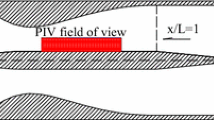Abstract
This experimental investigation deals with transition phenomena of a separated boundary layer under unsteady inlet flow conditions. The main purpose of this investigation is to understand the influence of the rotor-stator interaction in turbomachinery on the subsequent, highly loaded boundary layer. The research project is divided into two phases. In the first phase, which has been completed recently, only the variation of mean velocity caused by upstream blades was simulated in the experiments while the free-stream turbulence intensity was retained at a constant low level. The experiments are carried out in an Eifel-type wind tunnel to investigate the laminar separated boundary layer of a flat plate under oscillating inlet conditions. The adverse pressure gradient, similar to that of turbomachines, is generated by the contoured upper wall. The unsteadiness is produced by a rotating flap located downstream of the test section. The reduced frequency, the amplitude and the mean Reynolds number are varied to simulate the conditions prevailing in turbomachines. In addition to the Kelvin–Helmholtz instability of the separated shear layer, a lower frequency instability was observed. This is frequently referred to as `free shear layer flapping' and results in two distinctly different ways of re-attachment, depending primarily on the Reynolds number. For low momentum thickness Reynolds numbers at the separation point, large-scale vortices locked to the frequency of the unsteady main flow are identified. They originate nearly at the top of the separation bubble and are ejected downstream. A fully turbulent boundary layer develops after these vortices mix out. For higher Reynolds numbers, transition is completed within a short length of the free shear layer and there-attachment region. The characteristic momentum thickness Reynolds number separating these two regimes in unsteady flow is about 125. The Strouhal number (reduced frequency) does not appear to have any significant effect. Based on the experimental results, this behaviour is discussed in some detail.
Similar content being viewed by others
References
Drela, M., MISES implementation of modified Abu-Ghannam/Shaw transition criterion. MIT Aero-Astro (1995).
Gaster, M., The structure and behaviour of laminar separation bubbles. AGARD CP4 Part 2 (1966) pp. 813–854.
Eaton, J.K. and Johnston, J.P., Low frequency unsteadiness of a re-attaching turbulent shear layer. In: Bradbury, L.J.S., Durst, F., Launder, B.E., Schmidt, F.W. and Whitelaw, J.H. (eds.), Turbulent Shear Flows, Vol. 3. Springer-Verlag, Berlin (1982) pp. 162–170.
Hillier, R. and Chery, N.J., Pressure fluctuations under a turbulent shear layer. In: Proceedings of the 3rd Turbulent Shear Flow Symposium. University of California (1981) pp. 16–23–29.
Hourmouziadis, J., Buckl, F. and Bergmann, P., The development of the profile boundary layer in a turbine environment. In: ASME International Gas Turbine Conference, Dusseldorf, Germany, 8–12 June 1986. ASME, New York (1986) Paper No. 86–GT-244.
Hourmouziadis, J., Aerodynamic Design of Low Pressure Turbines. AGARD Lecture Series, Vol. 167, Blading Design for Axial Turbomachines (1989).
Hourmouziadis, J., Das DFG Verbundvorhaben Periodisch Instationare Stromung in Turbomaschinen. In: Deutscher Luft-and Raumfahrtkongress, Leipzig, Germany, 18–21 September (2000) DGLR-JT2000–030.
Lou, W. and Hourmouziadis, J., Experimental investigation of periodic-unsteady flat plate boundary layers with pressure gradients. In: Proceedings of the 3rd ASME/JSME Joint Fluids Engineering Conference & FED Summer Meeting/Exposition, San Francisco, CA, July 18–22. ASME, New York (1999).
Lou,W., Beitrag zur hochbelasteten Schaufelgrenzschicht, Dissertation, TU Berlin. VDI-Verlag (2000).
Mayle, R.E., The role of laminar/turbulent transition in gas turbine engines. ASME Journal of Turbomachinery 113 (1991) 509–537.
Pauley, L.L., Moin, P. and Reynolds, W.C., The structure of two-dimensional separation. Journal of Fluid Mechanics 220 (1990) 397–411.
Ripley, M.D. and Pauley, L.L., Unsteady structure of two-dimensional steady laminar separation. Physics of Fluids A 5(12) (1993) 3099–3106.
Rist, U., On instabilities and transition in laminar separation bubbles. In: Proceedings of the CEAS Aerospace Research Conference, 10–12 June 2002. Royal Aeronautical Society, Cambridge (2002) pp. 20.1–20.14.
Wissink, J.G. and Rodi, W., DNS of a laminar separation bubble in the presence of oscillating flow. In: Proceedings of the IUTAM Symposium on Unsteady Separated Flows, Toulouse, France, April 8–12 (2002).
Yang, Z. and Voke, P.E., Large-eddy simulation of boundary-layer separation and transition at a change of surface curvature. Journal of Fluid Mechanics 439 (2001) 305–303.
Loehrke, R.I., Morkovin, M.V., Fejer, A.A., Review-Transition in nonreversing oscillating boundary layers. ASME, Journal of Fluids Engineering (December 1975) 534–550.
Author information
Authors and Affiliations
Rights and permissions
About this article
Cite this article
Talan, M., Hourmouziadis, J. Characteristic Regimes of Transitional Separation Bubbles in Unsteady Flow. Flow, Turbulence and Combustion 69, 207–227 (2002). https://doi.org/10.1023/A:1027355105017
Issue Date:
DOI: https://doi.org/10.1023/A:1027355105017



